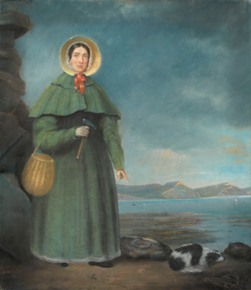 Geologist and science writer Nina Morgan reveals how Lyme Regis is once again on the tourist trail
Geologist and science writer Nina Morgan reveals how Lyme Regis is once again on the tourist trail
These days few would deny the important contributions made by the fossil collector Mary Anning (1799-1847). With little formal scientific education, but a keen eye, she combed the beaches around Lyme Regis collecting fossils to sell to tourists. Her extraordinary persistence paid off in many ways. After her father’s death in 1810, her fossil finds became her family’s main source of income. But it was her discovery of ever more complete ichthyosaur fossils, and then, in December 1823, the first complete plesiosaur fossil, that put her name firmly on the map as far as geologists and collectors were concerned. She went on to make many other important discoveries, including the first British pterodactyl, and gained the respect of many geologists, including Henry de la Beche (1796-1855) and William Buckland (1784-1856).
Lady Harriet Silvester, widow of the former Recorder of the City of London, after meeting Mary Anning in 1824, wrote:
“…the extraordinary thing in this young woman is that she has made herself so thoroughly acquainted with the science that the moment she finds any bones she knows to what tribe they belong …”
But even so, Mary is said to have believed that her name was better known abroad than at home. And her scientific skills were little appreciated by the locals. It seems that in Lyme, Mary was most appreciated for her ability to attract rich visitors. In the February 11 1865 issue of his magazine, All the Year Round, Charles Dickens noted that:
“In her own neighbourhood, Miss Anning was far from being a prophetess. Those who had derided her when she began her researches, now turned and laughed at her as an uneducated assuming person, who had made one good chance hit. Dr Buckland and Professor Owen and others knew her worth, and valued her accordingly; but she met with little sympathy in her own town, and the highest tribute which that magniloquent guide-book, The Beauties of Lyme Regis, can offer her, is to assure us that “her death was, in a pecuniary point, a great loss to the place, as her presence attracted a large number of distinguished visitors.” Quick returns are the thing at Lyme. We need not wonder that Miss Anning was chiefly valued as a bait for tourists, when we find that the museum is now entirely broken up, and the specimens returned to those who had lent them. No one had public spirit enough to take charge of a non-paying concern, when the early geological furore had calmed down, and people came to bathe and not to chop rocks. You may now visit the old abode of saurians without being able to see a single tolerable specimen.”
Fortunately the tide has turned, as far as fossils are concerned. Lyme Regis is now part of the Jurassic Coast World Heritage site; fossils and geology take pride of place in the restored Lyme Regis Museum; and Mary Anning’s reputation is once again pulling in the tourists.
Acknowledgments
Sources for this vignette include: Torrens, H S,
‘Mary Anning (1799 – 1847) of Lyme: “the greatest fossilist the world ever knew”, British Journal for the History of Science, vol 28, 1995, pp. 257-84; the article about Mary Anning by Hugh Torrens in the Oxford Dictionary of National Biography; the booklet
Mary Anning of Lyme Regis by Crispin Tickell published in 1996); the article
Mary Anning, the Fossil Finder, by Charles Dickens in
All the Year Round, February 11, 1865.
- If the past is the key to your present interests, why not join the History of Geology Group (HOGG). For more information and to read the latest HOGG Newsletter visit the HOGG website at: www.historyofgeologygroup.co.uk, where you’ll also find abstracts for the talks and posters presented at the Conference on Geological Collectors and Collecting, April 2011 available free to download as a pdf file.
*Nina Morgan is a geologist and science writer based near Oxford.